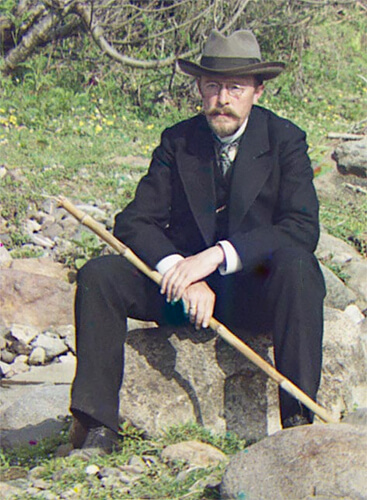Sergey Mikhaylovich Prokudin-Gorsky (Russian, August 30, 1863 Russian Empire – September 27, 1944) was a Russian chemist and photographer. He is best known for his pioneering work in color photography of early 20th-century Russia.
Prokudin-Gorsky was born in the ancestral estate of Funikova Gora, in what is now Kirzhachsky District, Vladimir Oblast. His parents were of the Russian nobility, and the family had a long military history. They moved to Saint Petersburg, where Prokudin-Gorsky enrolled in Saint Petersburg State Institute of Technology to study chemistry under Dmitri Mendeleev. He also studied music and painting at the Imperial Academy of Arts. In 1890, Prokudin-Gorsky married Anna Aleksandrovna Lavrova, and later the couple had two sons, Mikhail and Dmitri, and a daughter, Ekaterina. Anna was the daughter of the Russian industrialist Aleksandr Stepanovich Lavrov, an active member in the Imperial Russian Technical Society (IRTS). Prokudin-Gorsky subsequently became the director of the executive board of Lavrov's metal works near Saint Petersburg and remained so until the October Revolution. He also joined Russia's oldest photographic society, the photography section of the IRTS, presenting papers and lecturing on the science of photography. In 1901, he established a photography studio and laboratory in Saint Petersburg. In 1902, he traveled to Berlin and spent six weeks studying color sensitization and three-color photography with photochemistry professor Adolf Miethe, the most advanced practitioner in Germany at that time. Throughout the years, Prokudin-Gorsky's photographic work, publications and slide shows to other scientists and photographers in Russia, Germany and France earned him praise, and in 1906 he was elected the president of the IRTS photography section and editor of Russia's main photography journal, the Fotograf-Liubitel. Lithograph print of Leo Tolstoy in front of Prokudin-Gorsky's camera in Yasnaya Polyana, 1908.
Perhaps Prokudin-Gorsky's best-known work during his lifetime was his color portrait of Leo Tolstoy,[6] which was reproduced in various publications, on postcards, and as larger prints for framing. The fame from this photo and his earlier photos of Russia's nature and monuments earned him invitations to show his work to the Russian Grand Duke Michael Alexandrovich and Dowager Empress Maria Feodorovna in 1908, and to Tsar Nicholas II and his family in 1909. The Tsar enjoyed the demonstration, and, with his blessing, Prokudin-Gorsky got the permission and funding to document Russia in color.[8] In the course of ten years, he was to make a collection of 10,000 photos. Prokudin-Gorsky considered the project his life's work and continued his photographic journeys through Russia until after the October Revolution. He was appointed to a new professorship under the new regime, but he left the country in August 1918. He still pursued scientific work in color photography, published papers in English photography journals and, together with his colleague S. O. Maksimovich, obtained patents in Germany, England, France and Italy.
In 1920, Prokudin-Gorsky remarried and had a daughter with his assistant Maria Fedorovna née Schedrimo. The family finally settled in Paris in 1922, reuniting with his first wife and children. Prokudin-Gorsky set up a photo studio there together with his three adult children, naming it after his fourth child, Elka. In the 1930s, the elderly Prokudin-Gorsky continued with lectures showing his photographs of Russia to young Russians in France, but stopped commercial work and left the studio to his children, who named it Gorsky Frères. He died at Paris on September 27, 1944, and is buried in the Sainte-Geneviève-des-Bois Russian Cemetery.
Documentary of the Russian EmpireAround 1905, Prokudin-Gorsky envisioned and formulated a plan to use the emerging technological advances that had been made in color photography to document the Russian Empire systematically. Through such an ambitious project, his ultimate goal was to educate the schoolchildren of Russia with his "optical color projections" of the vast and diverse history, culture, and modernization of the empire. Outfitted with a specially equipped railroad-car darkroom provided by Tsar Nicholas II and in possession of two permits that granted him access to restricted areas and cooperation from the empire's bureaucracy, Prokudin-Gorsky documented the Russian Empire around 1909 through 1915. He conducted many illustrated lectures of his work. His photographs offer a vivid portrait of a lost world—the Russian Empire on the eve of World War I and the coming Russian Revolution. His subjects ranged from the medieval churches and monasteries of old Russia, to the railroads and factories of an emerging industrial power, to the daily life and work of Russia's diverse population. It has been estimated from Prokudin-Gorsky's personal inventory that before leaving Russia, he had about 3500 negatives. Upon leaving the country and exporting all his photographic material, about half of the photos were confiscated by Russian authorities for containing material that seemed to be strategically sensitive for war-time Russia. According to Prokudin-Gorsky's notes, the photos left behind were not of interest to the general public. Some of Prokudin-Gorsky's negatives were given away, and some he hid on his departure. Outside the Library of Congress collection, none has yet been found.
By Prokudin-Gorsky's death, the tsar and his family had long since been executed during the Russian Revolution, and Communist rule had been established over what was once the Russian Empire. The surviving boxes of photo albums and fragile glass plates the negatives were recorded on were finally stored in the basement of a Parisian apartment building, and the family was worried about them getting damaged. The United States Library of Congress purchased the material from Prokudin-Gorsky's heirs in 1948 for $3500–$5000 on the initiative of a researcher inquiring into their whereabouts. The library counted 1902 negatives and 710 album prints without corresponding negatives in the collection.
(Source: en.wikipedia.org)
